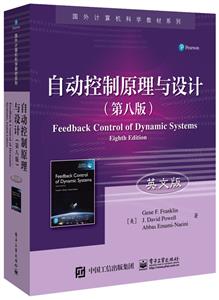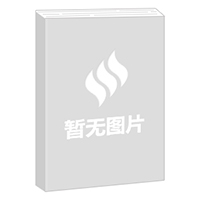包郵 國(guó)外計(jì)算機(jī)科學(xué)教材系列自動(dòng)控制原理與設(shè)計(jì)(第8版)(英文版)/(美)GeneF.Franklin
-
>
闖進(jìn)數(shù)學(xué)世界――探秘歷史名題
-
>
中醫(yī)基礎(chǔ)理論
-
>
當(dāng)代中國(guó)政府與政治(新編21世紀(jì)公共管理系列教材)
-
>
高校軍事課教程
-
>
思想道德與法治(2021年版)
-
>
毛澤東思想和中國(guó)特色社會(huì)主義理論體系概論(2021年版)
-
>
中醫(yī)內(nèi)科學(xué)·全國(guó)中醫(yī)藥行業(yè)高等教育“十四五”規(guī)劃教材
國(guó)外計(jì)算機(jī)科學(xué)教材系列自動(dòng)控制原理與設(shè)計(jì)(第8版)(英文版)/(美)GeneF.Franklin 版權(quán)信息
- ISBN:9787121404061
- 條形碼:9787121404061 ; 978-7-121-40406-1
- 裝幀:一般膠版紙
- 冊(cè)數(shù):暫無(wú)
- 重量:暫無(wú)
- 所屬分類:>>
國(guó)外計(jì)算機(jī)科學(xué)教材系列自動(dòng)控制原理與設(shè)計(jì)(第8版)(英文版)/(美)GeneF.Franklin 本書特色
適讀人群 :本書可作為高等院校自動(dòng)化類、電氣類、儀器類、機(jī)械類等相關(guān)專業(yè)高年級(jí)本科生的雙語(yǔ)教學(xué)教材,還可供從事半導(dǎo)體制造、汽車控制、宇航自動(dòng)化、運(yùn)動(dòng)控制、機(jī)器人、精密儀器等相關(guān)領(lǐng)域的教師和科技人員參考。本書是自動(dòng)控制領(lǐng)域的經(jīng)典著作,以自動(dòng)控制系統(tǒng)的分析和設(shè)計(jì)為主線,在回顧自動(dòng)控制系統(tǒng)動(dòng)態(tài)響應(yīng)和反饋控制的基本特性基礎(chǔ)上,重點(diǎn)介紹了自動(dòng)控制系統(tǒng)的3種主流設(shè)計(jì)方法:根軌跡設(shè)計(jì)方法、頻率響應(yīng)設(shè)計(jì)方法和狀態(tài)空間設(shè)計(jì)方法。此外,還闡述了非線性系統(tǒng)的分析與設(shè)計(jì),給出了汽車發(fā)動(dòng)機(jī)、無(wú)人機(jī)、半導(dǎo)體晶圓制造等應(yīng)用的控制系統(tǒng)設(shè)計(jì)實(shí)例。全書在闡述自動(dòng)控制原理和設(shè)計(jì)方法的過(guò)程中,適時(shí)地穿插了MATLAB仿真源代碼和仿真實(shí)驗(yàn)結(jié)果。
國(guó)外計(jì)算機(jī)科學(xué)教材系列自動(dòng)控制原理與設(shè)計(jì)(第8版)(英文版)/(美)GeneF.Franklin 內(nèi)容簡(jiǎn)介
本書是自動(dòng)控制領(lǐng)域的經(jīng)典著作,以自動(dòng)控制系統(tǒng)的分析和設(shè)計(jì)為主線,在回顧自動(dòng)控制系統(tǒng)動(dòng)態(tài)響應(yīng)和反饋控制的基本特性基礎(chǔ)上,重點(diǎn)介紹了自動(dòng)控制系統(tǒng)的3種主流設(shè)計(jì)方法:根軌跡設(shè)計(jì)方法、頻率響應(yīng)設(shè)計(jì)方法和狀態(tài)空間設(shè)計(jì)方法。此外,還闡述了非線性系統(tǒng)的分析與設(shè)計(jì),給出了汽車發(fā)動(dòng)機(jī)、無(wú)人機(jī)、半導(dǎo)體晶圓制造等應(yīng)用的控制系統(tǒng)設(shè)計(jì)實(shí)例。全書在闡述自動(dòng)控制原理和設(shè)計(jì)方法的過(guò)程中,適時(shí)地穿插了MATLAB仿真源代碼和仿真實(shí)驗(yàn)結(jié)果。
國(guó)外計(jì)算機(jī)科學(xué)教材系列自動(dòng)控制原理與設(shè)計(jì)(第8版)(英文版)/(美)GeneF.Franklin 目錄
A Perspective on Feedback Control
Chapter Overview
1.1 A Simple Feedback System
1.2 A First Analysis of Feedback
1.3 Feedback System Fundamentals
1.4 A Brief History
1.5 An Overview of the Book
Summary
Review Questions
Problems
Chapter 2 Dynamic Models
A Perspective on Dynamic Models
Chapter Overview
2.1 Dynamics of Mechanical Systems
2.1.1 Translational Motion
2.1.2 Rotational Motion
2.1.3 Combined Rotation and Translation
2.1.4 Complex Mechanical Systems (W)①
2.1.5 Distributed Parameter Systems
2.1.6 Summary: Developing Equations of Motion for Rigid Bodies
2.2 Models of Electric Circuits
2.3 Models of Electromechanical Systems
2.3.1 Loudspeakers
2.3.2 Motors
△ 2.3.3 Gears
△ 2.4 Heat and Fluid-Flow Models
2.4.1 Heat Flow
2.4.2 Incompressible Fluid Flow
2.5 Historical Perspective
Summary
Review Questions
Problems
Chapter 3 Dynamic Response
A Perspective on System Response
Chapter Overview
3.1 Review of Laplace Transforms
3.1.1 Response by Convolution
3.1.2 Transfer Functions and Frequency Response
3.1.3 The ?_ Laplace Transform
3.1.4 Properties of Laplace Transforms
3.1.5 Inverse Laplace Transform by Partial-Fraction Expansion
3.1.6 The Final Value Theorem
3.1.7 Using Laplace Transforms to Solve Differential Equations
3.1.8 Poles and Zeros
3.1.9 Linear System Analysis Using Matlab
3.2 System Modeling Diagrams
3.2.1 The Block Diagram
3.2.2 Block-Diagram Reduction Using Matlab
3.2.3 Mason’s Rule and the Signal Flow Graph (W)
3.3 Effect of Pole Locations
3.4 Time-Domain Specifications
3.4.1 Rise Time
3.4.2 Overshoot and Peak Time
3.4.3 Settling Time
3.5 Effects of Zeros and Additional Poles
3.6 Stability
3.6.1 Bounded Input-Bounded Output Stability
3.6.2 Stability of LTI Systems
3.6.3 Routh’s Stability Criterion
△ 3.7 Obtaining Models from Experimental Data: System Identification (W)
△ 3.8 Amplitude and Time Scaling (W)
3.9 Historical Perspective
Summary
Review Questions
Problems
Chapter 4 A First Analysis of Feedback
A Perspective on the Analysis of Feedback
Chapter Overview
4.1 The Basic Equations of Control
4.1.1 Stability
4.1.2 Tracking
4.1.3 Regulation
4.1.4 Sensitivity
4.2 Control of Steady-State Error to Polynomial Inputs: System Type
4.2.1 System Type for Tracking
4.2.2 System Type for Regulation and Disturbance Rejection
4.3 The Three-Term Controller: PID Control
4.3.1 Proportional Control (P)
4.3.2 Integral Control (I)
4.3.3 Derivative Control (D)
4.3.4 Proportional Plus Integral Control (PI)
4.3.5 PID Control
4.3.6 Ziegler-Nichols Tuning of the PID Controller
4.4 Feedforward Control by Plant Model Inversion
△ 4.5 Introduction to Digital Control (W)
△ 4.6 Sensitivity of Time Response to Parameter Change (W)
4.7 Historical Perspective
Summary
Review Questions
Problems
Chapter 5 The Root-Locus Design Method
A Perspective on the Root-Locus Design Method
Chapter Overview
5.1 Root Locus of a Basic Feedback System
5.2 Guidelines for Determining a Root Locus
5.2.1 Rules for Determining a Positive (180°) Root Locus
5.2.2 Summary of the Rules for Determining a Root Locus
5.2.3 Selecting the Parameter Value
5.3 Selected Illustrative Root Loci
5.4 Design Using Dynamic Compensation
5.4.1 Design Using Lead Compensation
5.4.2 Design Using Lag Compensation
5.4.3 Design Using Notch Compensation
△ 5.4.4 Analog and Digital Implementations (W)
5.5 Design Examples Using the Root Locus
5.6 Extensions of the Root-Locus Method
5.6.1 Rules for Plotting a Negative (0°) Root Locus
△ 5.6.2 Successive Loop ClosureS
△ 5.6.3 Time Delay (W)
5.7 Historical Perspective
Summary
Review Questions
Problems
Chapter 6 The Frequency-Response Design Method
A Perspective on the Frequency-Response Design Method
Chapter Overview
6.1 Frequency Response
6.1.1 Bode Plot Techniques
6.1.2 Steady-State Errors
6.2 Neutral Stability
6.3 The Nyquist Stability Criterion
6.3.1 The Argument Principle
6.3.2 Application of The Argument Principle to Control Design
6.4 Stability Margins
6.5 Bode’s Gain-Phase Relationship
6.6 Closed-Loop Frequency Response
6.7 Compensation
6.7.1 PD Compensation
6.7.2 Lead Compensation (W)
6.7.3 PI Compensation
6.7.4 Lag Compensation
6.7.5 PID Compensation
6.7.6 Design Considerations
△ 6.7.7 Specifications in Terms of the Sensitivity Function
△ 6.7.8 Limitations on Design in Terms of the Sensitivity Function
△ 6.8 Time Delay
6.8.1 Time Delay via the Nyquist Diagram (W)
△ 6.9 Alternative Presentation of Data
6.9.1 Nichols Chart
6.9.2 The Inverse Nyquist Diagram (W)
6.10?Historical Perspective
Summary
Review Questions
Problems
Chapter 7 State-Space Design
A Perspective on State-Space Design
Chapter Overview
7.1 Advantages of State-Space
7.2 System Description in State-Space
7.3 Block Diagrams and State-Space
7.4 Analysis of the State Equations
7.4.1 Block Diagrams and Canonical Forms
7.4.2 Dynamic Response from the State Equations
7.5 Control-Law Design for Full-State Feedback
7.5.1 Finding the Control Law
7.5.2 Introducing the Reference Input with Full-State Feedback
7.6 Selection of Pole Locations for Good Design
7.6.1 Dominant Second-Order Poles
7.6.2 Symmetric Root Locus (SRL)
7.6.3 Comments on the Methods
7.7 Estimator Design
7.7.1 Full-Order Estimators
7.7.2 Reduced-Order Estimators
7.7.3 Estimator Pole Selection
7.8 Compensator Design: Combined Control Law and Estimator (W)
7.9 Introduction of the Reference Input with the Estimator (W)
7.9.1 General Structure for the Reference Input
7.9.2 Selecting the Gain
7.10?Integral Control and Robust Tracking
7.10.1?Integral Control
△ 7.10.2?Robust Tracking Control: The Error-Space Approach
△ 7.10.3?Model-Following Design
△ 7.10.4?The Extended Estimator
△ 7.11?Loop Transfer Recovery
△ 7.12?Direct Design with Rational Transfer Functions
△ 7.13?Design for Systems with Pure Time Delay
7.14?Solution of State Equations (W)
7.15?Historical Perspective
Summary
Review Questions
Problems
Chapter 8 Digital Control
A Perspective on Digital Control
Chapter Overview
8.1 Digitization
8.2 Dynamic Analysis of Discrete Systems
8.2.1 z-Transform
8.2.2 z-Transform Inversion
8.2.3 Relationship Between s and z
8.2.4 Final Value Theorem
8.3 Design Using Discrete Equivalents
8.3.1 Tustin’s Method
8.3.2 Zero-Order Hold (ZOH) Method
8.3.3 Matched Pole-Zero (MPZ) Method
8.3.4 Modified Matched Pole-Zero (MMPZ) Method
8.3.5 Comparison of Digital Approximation Methods
8.3.6 Applicability Limits of the Discrete Equivalent Design Method
8.4 Hardware Characteristics
8.4.1 Analog-to-Digital (A/D) Converters
8.4.2 Digital-to-Analog Converters
8.4.3 Anti-Alias Prefilters
8.4.4 The Computer
8.5 Sample-Rate Selection
8.5.1 Tracking Effectiveness
8.5.2 Disturbance Rejection
8.5.3 Effect of Anti-Alias Prefilter
8.5.4 Asynchronous Sampling
△ 8.6 Discrete Design
8.6.1 Analysis Tools
8.6.2 Feedback Properties
8.6.3 Discrete Design Example
8.6.4 Discrete Analysis of Designs
8.7 Discrete State-Space Design Methods (W)
8.8 Historical Perspective
Summary
Review Questions
Problems
Chapter 9 Nonlinear Systems
A Perspective on Nonlinear Systems
Chapter Overview
9.1 Introduction and Motivation: Why Study Nonlinear Systems?
9.2 Analysis by Linearization
9.2.1 Linearization by Small-Signal Analysis
9.2.2 Linearization by Nonlinear Feedback
9.2.3 Linearization by Inverse Nonlinearity
9.3 Equivalent Gain Analysis Using the Root Locus
9.3.1 Integrator Antiwindup
9.4 Equivalent Gain Analysis Using Frequency Response: Describing Functions
9.4.1 Stability Analysis Using Describing Functions
△ 9.5 Analysis and Design Based on Stability
9.5.1 The Phase Plane
9.5.2 Lyapunov Stability Analysis
9.5.3 The Circle Criterion
9.6 Historical Perspective
Summary
Review Questions
Problems
Chapter 10 Control System Design: Principles and Case Studies
A Perspective on Design Principles
Chapter Overview
10.1 An Outline of Control Systems Design
10.2 Design of a Satellite’s Attitude Control
10.3 Lateral and Longitudinal Control of a Boeing 747
? 10.3.1 Yaw Damper
? 10.3.2 Altitude-Hold Autopilot
10.4 Control of the Fuel-Air Ratio in an Automotive Engine
10.5 Control of a Quadrotor Drone
10.6 Control of RTP Systems in Semiconductor Wafer Manufacturing
10.7 Chemotaxis, or How E. Coli Swims Away from Trouble
10.8 Historical Perspective
Summary
Review Questions
Problems
Appendix A Laplace Transforms
A.1 The ?_ Laplace Transform
?A.1.1 Properties of Laplace Transforms
?A.1.2 Inverse Laplace Transform by Partial-Fraction Expansion
?A.1.3 The Initial Value Theorem
?A.1.4 Final Value Theorem
Appendix B Solutions to the Review Questions
Appendix C Matlab Commands
Bibliography
List of Appendices on the Web①
Appendix WA A Review of Complex Variables
Appendix WB Summary of Matrix Theory
Appendix WC Controllability and Observability
Appendix WD Ackermann’s Formula for Pole Placement
Appendix W2.1.4 Complex Mechanical Systems
Appendix W3.2.3 Mason’s Rule and the Signal-Flow Graph
Appendix W3.6.3.1 Routh Special Cases
Appendix W3.7 System Identification
Appendix W3.8 Amplitude and Time Scaling
Appendix W4.1.4.1 The Filtered Case
Appendix W4.2.2.1 Truxal’s Formula for the Error Constants
Appendix W4.5 Introduction to Digital Control
Appendix W4.6 Sensitivity of Time Response to Parameter Change
Appendix W5.4.4 Analog and Digital Implementations
Appendix W5.6.3 Root Locus with Time Delay
Appendix W6.7.2 Digital Implementation of Example 6.15
Appendix W6.8.1 Time Delay via the Nyquist Diagram
Appendix W6.9.2 The Inverse Nyquist Diagram
Appendix W7.8 Digital Implementation of Example 7.31
Appendix W7.9 Digital Implementation of Example 7.33
Appendix W7.14 Solution of State Equations
Appendix W8.7 Discrete State-Space Design Methods
國(guó)外計(jì)算機(jī)科學(xué)教材系列自動(dòng)控制原理與設(shè)計(jì)(第8版)(英文版)/(美)GeneF.Franklin 作者簡(jiǎn)介
Gene F. Franklin,美國(guó)斯坦福大學(xué)電氣工程系教授。國(guó)際著名控制學(xué)家,IEEE終身會(huì)士。于1955年在哥倫雙亞大學(xué)獲得博士學(xué)位,曾任斯坦福大學(xué)電氣工程系主任、IEEE控制系統(tǒng)學(xué)會(huì)理事、副主席,其研究領(lǐng)域覆蓋了控制和各個(gè)方面。2005年因其對(duì)多個(gè)控制領(lǐng)域的基礎(chǔ)性貢獻(xiàn)而美國(guó)自動(dòng)控制學(xué)會(huì)**獎(jiǎng)Bellman獎(jiǎng)。Gene F. Franklin,美國(guó)斯坦福大學(xué)電氣工程系教授。國(guó)際著名控制學(xué)家,IEEE終身會(huì)士。于1955年在哥倫雙亞大學(xué)獲得博士學(xué)位,曾任斯坦福大學(xué)電氣工程系主任、IEEE控制系統(tǒng)學(xué)會(huì)理事、副主席,其研究領(lǐng)域覆蓋了控制和各個(gè)方面。2005年因其對(duì)多個(gè)控制領(lǐng)域的基礎(chǔ)性貢獻(xiàn)而美國(guó)自動(dòng)控制學(xué)會(huì)**獎(jiǎng)Bellman獎(jiǎng)。
- >
苦雨齋序跋文-周作人自編集
- >
二體千字文
- >
伊索寓言-世界文學(xué)名著典藏-全譯本
- >
大紅狗在馬戲團(tuán)-大紅狗克里弗-助人
- >
羅庸西南聯(lián)大授課錄
- >
莉莉和章魚
- >
有舍有得是人生
- >
【精裝繪本】畫給孩子的中國(guó)神話

















